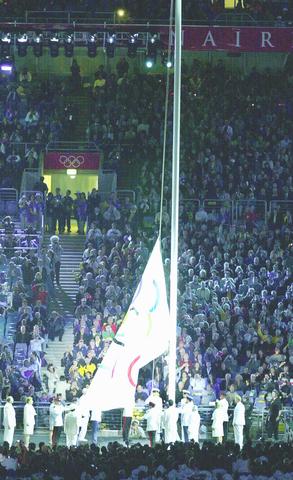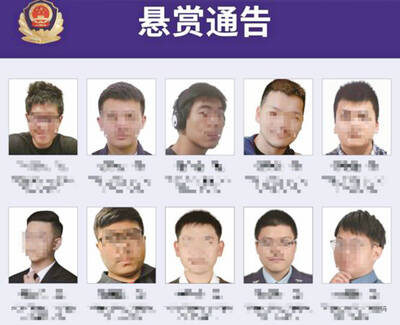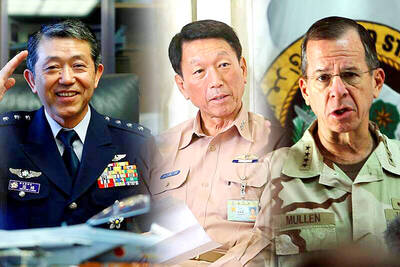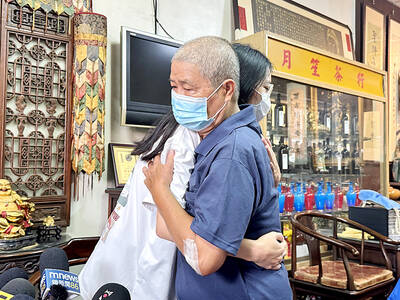Australia pulled out all the stops yesterday in its opening ceremony for the Sydney 2000 Games using a dazzling display of dance, song, and celebration of the Olympic spirit to try to rekindle the spirit of the Games.
"The Games belong to the athletes, this night belongs to the athletes, this is your time enjoy it, said Michael Knight, president of the Sydney Organization Committee of the Olympic Games.
From its beginning, where 120 riders dressed as stockmen trotted into the stadium on horses, to the lighting of the ceremonial Olympic flame by Australian Aboriginal runner Cathy Freeman, the ceremony was full of surprises.

PHOTO: LIN CHENG-KUNG, TAIPEI TIMES
After the horses weaved in between one another to form the Olympic symbol of five rings, spectators were given a diverse visual performance which traced Australia's history.
The story began when the stadium was turned into a fish bowl.
A young girl -- the main character of the entire performance -- and others were hoisted high up on cables, giving spectators the impression that they were swimming through the air.
In addition to the schools of fish on the ground and in the air, a lone worm dangled lazily in the air on a larger than life fish-hook.
Aboriginal dances followed and then characters standing on stilts gracefully walked around the track field cutting through billows of smoke as if they were flying.
After the dances came fire, symbolic of the fire Aborigines in Australia used to control the growth of bush.
Next was a colorful dance of the fauna and flora of Australia -- an element of this country that originally attracted settlers to come here.
The visual display of flowers was followed by a "Tin Symphony" which focussed on the industrial revolution from the arrival of Europeans in Australia and in which the visual dance and display included gymnasts swinging and rolling in tin pipe sections, or jumping in the air with hundreds of tap dancers on tin sheeting.
The main performance was followed by a 2,000 member marching band which was proceeded by the beginning of the athletes march onto the field.
Some 200 countries took part in the march and based on their supporters in the crowd cries would rise and fall in succession.
Many of the athletes, in addition to filming themselves being filmed and watched by the world, rushed towards the crowds, or threw candy to cheering fans.
The Croatian team started a trend that others followed, throwing their hats into the crowd.
The Korean team marched in hand-in-hand to a wave of emotion from the crowd.
When Taiwan's team walked into the stadium they were greeted with warm applause. Team members carried kites and were dressed in white track suits.
Chiang Peng-lung (蔣澎龍), a 24-year-old member of Taiwan's table tennis team, waved the flag ecstatically from side to side as he marched in front of the team.
While all of the athletes were cheerful and a small group in one corner of the stadium waved a large Taiwan flag in support, some athletes like Lin Yi-chun (
"I had even gone out and had my dress suit tailored so it would fit me properly, " Lin told the Taipei Times before the ceremony.
For reasons yet unknown Taiwan's team was unable to purchase shoes to match their suits for the Olympics so in the end they wore track suits so that all of the athletes would be dressed alike.
As athletes stood in the center of the field and blue lights sparkled in the stadium stands, the Olympic flag was raised.
During the athletes' oath this year there was an additional explicit pledge to not use drugs.
But the surprise of the evening was the carrying of the torch by 400m runner Cathy Freeman, an Aborigine.
Standing in the middle of a pool of water, Freeman lit the Olympic torch, which then raised above her looking much like a flying saucer with a hole in its center.
After she stepped out from under the flaming torch and stepped to the side the flame climbed to the top of the edge of the stadium while a waterfall cascading down below it.

A Chinese aircraft carrier group entered Japan’s economic waters over the weekend, before exiting to conduct drills involving fighter jets, the Japanese Ministry of Defense said yesterday. The Liaoning aircraft carrier, two missile destroyers and one fast combat supply ship sailed about 300km southwest of Japan’s easternmost island of Minamitori on Saturday, a ministry statement said. It was the first time a Chinese aircraft carrier had entered that part of Japan’s exclusive economic zone (EEZ), a ministry spokesman said. “We think the Chinese military is trying to improve its operational capability and ability to conduct operations in distant areas,” the spokesman said. China’s growing

Taiwan yesterday denied Chinese allegations that its military was behind a cyberattack on a technology company in Guangzhou, after city authorities issued warrants for 20 suspects. The Guangzhou Municipal Public Security Bureau earlier yesterday issued warrants for 20 people it identified as members of the Information, Communications and Electronic Force Command (ICEFCOM). The bureau alleged they were behind a May 20 cyberattack targeting the backend system of a self-service facility at the company. “ICEFCOM, under Taiwan’s ruling Democratic Progressive Party, directed the illegal attack,” the warrant says. The bureau placed a bounty of 10,000 yuan (US$1,392) on each of the 20 people named in

Nine retired generals from Taiwan, Japan and the US have been invited to participate in a tabletop exercise hosted by the Taipei School of Economics and Political Science Foundation tomorrow and Wednesday that simulates a potential Chinese invasion of Taiwan in 2030, the foundation said yesterday. The five retired Taiwanese generals would include retired admiral Lee Hsi-min (李喜明), joined by retired US Navy admiral Michael Mullen and former chief of staff of the Japan Self-Defense Forces general Shigeru Iwasaki, it said. The simulation aims to offer strategic insights into regional security and peace in the Taiwan Strait, it added. Foundation chair Huang Huang-hsiung

PUBLIC WARNING: The two students had been tricked into going to Hong Kong for a ‘high-paying’ job, which sent them to a scam center in Cambodia Police warned the public not to trust job advertisements touting high pay abroad following the return of two college students over the weekend who had been trafficked and forced to work at a cyberscam center in Cambodia. The two victims, surnamed Lee (李), 18, and Lin (林), 19, were interviewed by police after landing in Taiwan on Saturday. Taichung’s Chingshui Police Precinct said in a statement yesterday that the two students are good friends, and Lin had suspended her studies after seeing the ad promising good pay to work in Hong Kong. Lee’s grandfather on Thursday reported to police that Lee had sent